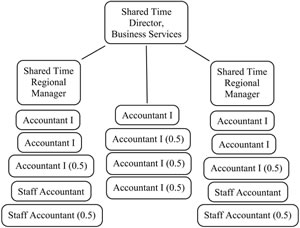Saving Crucial Education Dollars
- By Thomas A. DeLuca
- 03/01/14
Genesee Intermediate School District (GISD) is located on Michigan’s Lower Peninsula and encompasses one large urban school district surrounded by several suburban and rural districts. About 10 years ago, GISD superintendents shared their concerns that enrollments and revenue were declining, while expenditures, such as salary increments and healthcare costs, continued to rise. Additionally, some districts chose not to fill staff vacancies as a cost-saving method, whereas other districts had difficulty filling positions that required specialized personnel.
As the result of reductions in business service staff, an increasing number of districts were receiving financial audit findings related to the segregation of cash management duties.
District leaders began considering alternative service delivery models to preserve the fiscal stability and reputation of the local districts. One such model was consolidation.
GISD manages a fiber-optic network that delivers high-speed communications between local districts and the ISD offices. That network provides a highly secure system that serves as the platform for inter-district connectivity. In addition, the districts had a common accounting software platform. With the infrastructure and common software applications in place, GISD was able to offer individual business services to its constituent districts.
Impetus for consolidation
Why would local districts consolidate business services to the ISD? Within GISD, the reasons ranged from meeting an immediate need to anticipated cost savings. As Cynthia McCain, assistant superintendent of business, describes, “One local district could not find a qualified payroll applicant willing to travel to that [rural] district, while in a second district, the business manager left unexpectedly.” In a third situation, “we walked into a district because the accountant couldn’t close the books for the audit and it was already mid-November.” In Michigan, if you do not submit the district audit and financial data by Nov. 15, state aid is withheld until the audit and figures are submitted.
On the other hand, John Fazer, superintendent of Goodrich Area Schools, says the decision was “based on personnel and dollars. The ISD provided our accounts payable services. And when our payroll person left, rather than hiring a new person, we contracted with the ISD for payroll services since they were already managing our accounts payable and receivable.”
Shared service organizational structure
As the volume of local districts requesting ISD business services grew, the GISD superintendent and board of education hired a shared services director whose sole responsibility was to manage local district operations from the ISD. To meet demand, the GISD superintendent and board also added two regional managers, each focused on a limited number of local districts and each providing customized services.

Figure 1. GISD Shared Services Organizational Structure, 2012
What started as a typical ISD response to support a local district facing an emergency situation turned into a service delivery model and internal organization that now supports more than half of the local districts within GISD (see Figure 1).
McCain shares, “I believe flexibility is one factor that made our model successful. I designed the service models around the needs of the local district. I will work with [district administrators] to provide only the needed services.”
What started as a common ISD response to an urgent local district need has developed into a service delivery model that appears to reduce spending yet provides substantial service quality improvements over locally maintained business services; true economies of scale in action.
This article originally appeared in the issue of .
About the Author
Thomas A. DeLuca, a former finance director, is assistant professor of educational leadership and policy studies at the University of Kansas, Lawrence. He can be reached at [email protected]. This article is excerpted with permission from the February 2014 issue of School Business Affairs, published by the Association of School Business Officials International,www.asbointl.org.